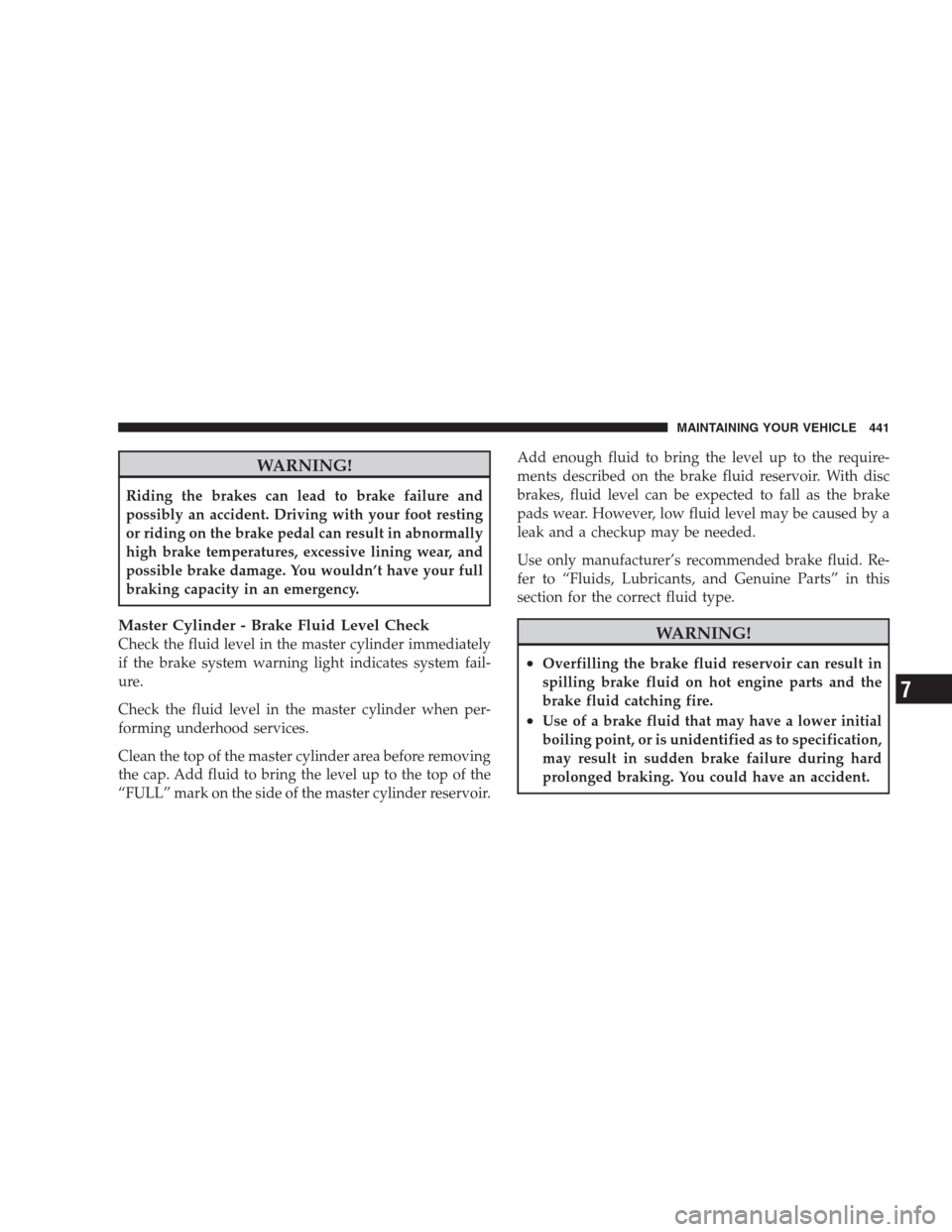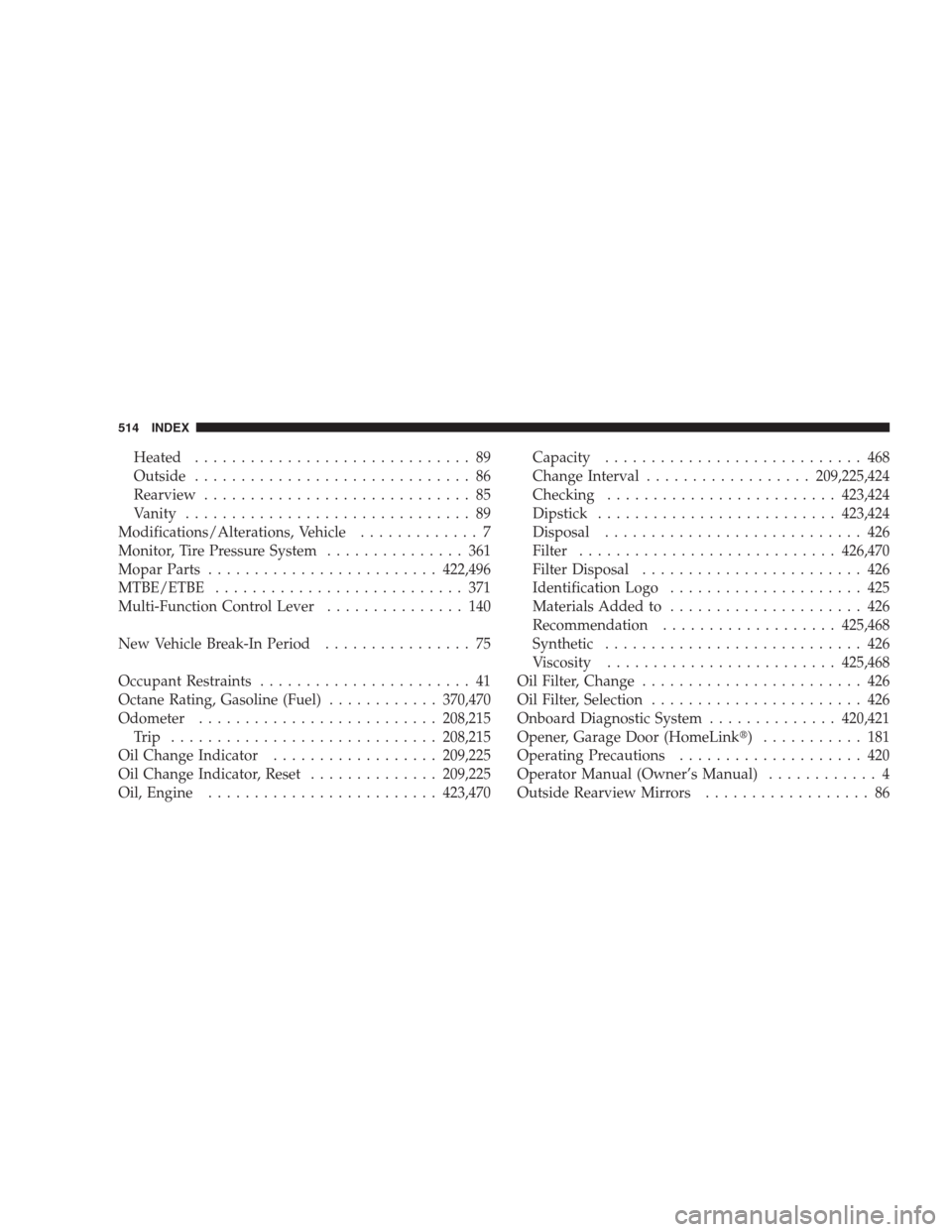Page 359 of 526

Keep dismounted tires in a cool, dry place with as little
exposure to light as possible. Protect tires from contact
with oil, grease, and gasoline.
Replacement Tires
The tires on your new vehicle provide a balance of many
characteristics. They should be inspected regularly for
wear and correct cold tire inflation pressure. The manu-
facturer strongly recommends that you use tires equiva-
lent to the originals in size, quality and performance
when replacement is needed. (Refer to the paragraph on
“Tread Wear Indicators”). Refer to the “Tire and Loading
Information” placard for the size designation of your tire.
The service description and load identification will be
found on the original equipment tire. Failure to use
equivalent replacement tires may adversely affect the
safety, handling, and ride of your vehicle. We recommend
that you contact your original equipment or an autho-
rized tire dealer with any questions you may have on tire
specifications or capability.
WARNING!
•Do not use a tire, wheel size or rating other than
that specified for your vehicle. Some combinations
of unapproved tires and wheels may change sus-
pension dimensions and performance characteris-
tics, resulting in changes to steering, handling, and
braking of your vehicle. This can cause unpredict-
able handling and stress to steering and suspen-
sion components. You could lose control and have
an accident resulting in serious injury or death.
Use only the tire and wheel sizes with load ratings
approved for your vehicle.
•Never use a tire with a smaller load index or
capacity, other than what was originally equipped
on your vehicle. Using a tire with a smaller load
index could result in tire overloading and failure.
You could lose control and have an accident.
(Continued)
STARTING AND OPERATING 357
5
Page 443 of 526

WARNING!
Riding the brakes can lead to brake failure and
possibly an accident. Driving with your foot resting
or riding on the brake pedal can result in abnormally
high brake temperatures, excessive lining wear, and
possible brake damage. You wouldn’t have your full
braking capacity in an emergency.
Master Cylinder - Brake Fluid Level Check
Check the fluid level in the master cylinder immediately
if the brake system warning light indicates system fail-
ure.
Check the fluid level in the master cylinder when per-
forming underhood services.
Clean the top of the master cylinder area before removing
the cap. Add fluid to bring the level up to the top of the
“FULL” mark on the side of the master cylinder reservoir.Add enough fluid to bring the level up to the require-
ments described on the brake fluid reservoir. With disc
brakes, fluid level can be expected to fall as the brake
pads wear. However, low fluid level may be caused by a
leak and a checkup may be needed.
Use only manufacturer’s recommended brake fluid. Re-
fer to “Fluids, Lubricants, and Genuine Parts” in this
section for the correct fluid type.WARNING!
•Overfilling the brake fluid reservoir can result in
spilling brake fluid on hot engine parts and the
brake fluid catching fire.
•Use of a brake fluid that may have a lower initial
boiling point, or is unidentified as to specification,
may result in sudden brake failure during hard
prolonged braking. You could have an accident.
MAINTAINING YOUR VEHICLE 441
7
Page 516 of 526

Heated.............................. 89
Outside.............................. 86
Rearview............................. 85
Vanity............................... 89
Modifications/Alterations, Vehicle............. 7
Monitor, Tire Pressure System............... 361
Mopar Parts.........................422,496
MTBE/ETBE........................... 371
Multi-Function Control Lever............... 140
New Vehicle Break-In Period................ 75
Occupant Restraints....................... 41
Octane Rating, Gasoline (Fuel)............370,470
Odometer..........................208,215
Trip .............................208,215
Oil Change Indicator..................209,225
Oil Change Indicator, Reset..............209,225
Oil, Engine.........................423,470Capacity............................ 468
Change Interval..................209,225,424
Checking.........................423,424
Dipstick..........................423,424
Disposal............................ 426
Filter............................426,470
Filter Disposal........................ 426
Identification Logo..................... 425
Materials Added to..................... 426
Recommendation...................425,468
Synthetic............................ 426
Viscosity.........................425,468
Oil Filter, Change........................ 426
Oil Filter, Selection....................... 426
Onboard Diagnostic System..............420,421
Opener, Garage Door (HomeLink�) ........... 181
Operating Precautions.................... 420
Operator Manual (Owner’s Manual)............ 4
Outside Rearview Mirrors.................. 86
514 INDEX